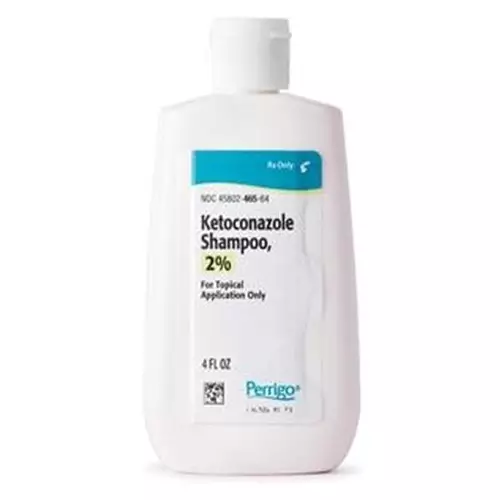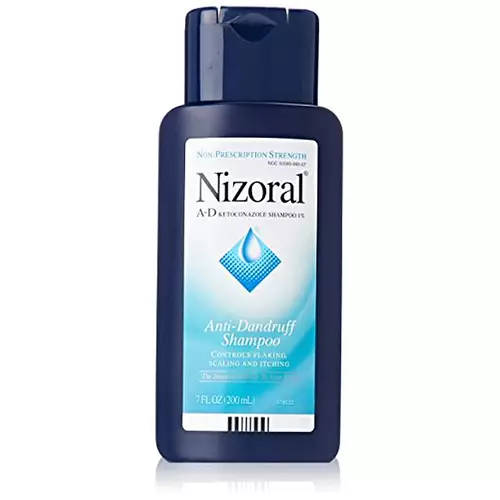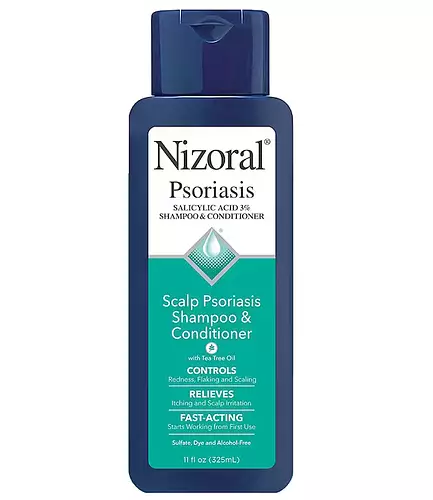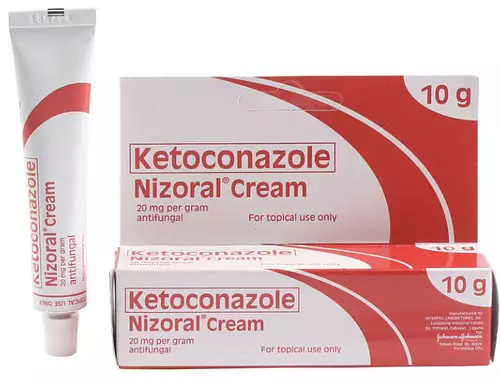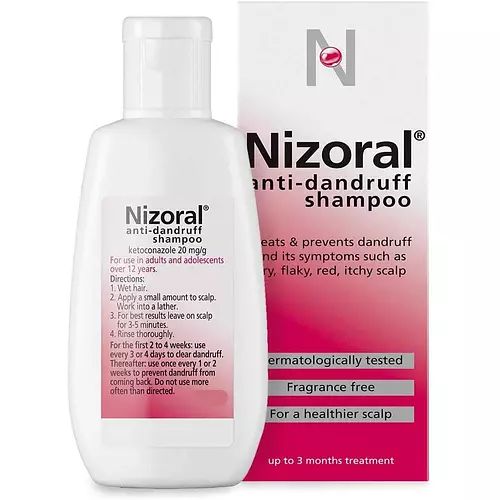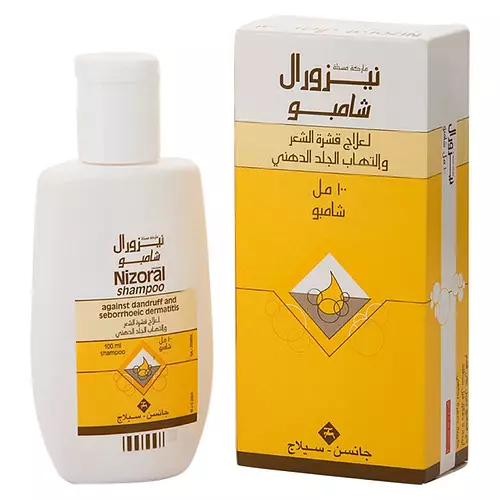
Nizoral 2% Shampoo Ingredients Explained
Updated on May 15, 2024 Submitted by Rana2024
Overview
What it is
Shampoo with 12 ingredients
Cool Features
It is reef safe
Suited For
It has ingredients that are good for anti aging
Free From
It doesn't contain any harsh alcohols, common allergens, fragrances, oils, parabens or silicones
Fun facts
Nizoral is from United States. This product is used in 2 routines created by our community.
We independently verify ingredients and our claims are backed by peer-reviewed research. Does this product need an update? Let us know.
Shampoo with 12 ingredients
Quick info
You should know
Benefits
This product contains 1 ingredient that may have this attribute:
Concerns
This product contains 2 ingredients that may have this attribute:
This product contains 1 ingredient that may have this attribute:
This product contains 1 ingredient that may have this attribute:
This product contains 2 ingredients that may have this attribute:
This product contains 1 ingredient that may have this attribute:
This product contains 1 ingredient that may have this attribute:
Ingredients 12
Sodium Lauryl Sulfate (SLS) is a sulfate with surfactant properties.
Butanedioic Acid, Sulfo-, C-[2-[2-[(1-Oxo-9-Octadecenyl)Amino]Ethoxy]Ethyl] Ester, Disodium Salt;
Laurdimonium Hydroxypropyl Hydrolyzed Collagen can help to reduce the effects of aging.
Peg-120 Methyl Glucose Dioleate is used to improve texture and stability of a product. It is sugar based and helps thicken a product.
Chances are, you eat sodium chloride every day. Sodium Chloride is also known as table salt.
Imidazolidinyl Urea is a preservative and isn't fungal acne safe. It can cause irritation and worsen eczema.
Sodium Hydroxide is also known as lye or caustic soda. It is used to adjust the pH of products; many ingredients require a specific pH to be effective.
Water. It's the most common cosmetic ingredient of all. You'll usually see it at the top of ingredient lists, meaning that it makes up the largest part of the product.
Ingredient Ratings
Based on the number of likes and dislikes each ingredient has received.
Ingredients Explained
This is not an INCI ingredient.
Ketoconazole is a pharmaceutical ingredient used to treat fungal infections. It is best to speak with a medical professional about using this ingredient.
Sodium Lauryl Sulfate (SLS) is a sulfate with surfactant properties.
The surfactant property make it a great foam creator and cleansing agent. Surfactants help bind ingredients that normally do not mix.
Some studies have shown skin irritation due to prolonged SLS use.
Sodium Laureth Sulfate (SLES) is a milder version of SLS.
Learn more about Sodium Lauryl SulfateButanedioic Acid, Sulfo-, C-[2-[2-[(1-Oxo-9-Octadecenyl)Amino]Ethoxy]Ethyl] Ester, Disodium Salt;
Coconut Acid isn't fungal acne safe.
Laurdimonium Hydroxypropyl Hydrolyzed Collagen can help to reduce the effects of aging.
Peg-120 Methyl Glucose Dioleate is used to improve texture and stability of a product. It is sugar based and helps thicken a product.
Once applied, it also creates a thin film to trap moisture in. This helps keep your skin hydrated.
This ingredient is the polyethylene glycol ether of the diester of oleic acid and methylglucose. The 120 represents an average of 120 moles of ethylene oxide.
There is limited research on this ingredient, although it is considered safe to use in skincare products.
Learn more about Peg-120 Methyl Glucose DioleateChances are, you eat sodium chloride every day. Sodium Chloride is also known as table salt.
This ingredient has many purposes in skincare: thickener, emulsifier, and exfoliator.
You'll most likely find this ingredient in cleansers where it is used to create a gel-like texture. As an emulsifier, it also prevents ingredients from separating.
There is much debate on whether this ingredient is comedogenic. The short answer - comedogenic ratings don't tell the whole story. Learn more about comegodenic ratings here.
The concensus about this ingredient causing acne seems to be divided. Research is needed to understand if this ingredient does cause acne.
Scrubs may use salt as the primary exfoliating ingredient.
Learn more about Sodium ChlorideImidazolidinyl Urea is a preservative and isn't fungal acne safe. It can cause irritation and worsen eczema.
Sodium Hydroxide is also known as lye or caustic soda. It is used to adjust the pH of products; many ingredients require a specific pH to be effective.
In small amounts, sodium hydroxide is considered safe to use. However, large amounts may cause chemical burns due to its high alkaline.
Your skin has a natural pH and acid mantle. This acid mantle helps prevent harmful bacteria from breaking through. The acid mantle also helps keep your skin hydrated.
"Alkaline" refers to a high pH level. A low pH level would be considered acidic.
Learn more about Sodium HydroxideWe don't have a description for Hydrochloric Acid.
We don't have a description for Ci 45430.
Water. It's the most common cosmetic ingredient of all. You'll usually see it at the top of ingredient lists, meaning that it makes up the largest part of the product.
So why is it so popular? Water most often acts as a solvent - this means that it helps dissolve other ingredients into the formulation.
You'll also recognize water as that liquid we all need to stay alive. Talk about multi-purpose! If you see this, drink a glass of water. Stay hydrated!
Learn more about WaterWhen to use
How this product is used by our community
Directions
• Wet hair thoroughly.
• Apply a small amount of Nizoral 2% shampoo to your scalp.
• Work into a lather and massage gently for a few minutes.
• Rinse thoroughly and repeat the process.
• Leave...
• Wet hair thoroughly.
• Apply a small amount of Nizoral 2% shampoo to your scalp.
• Work into a lather and massage gently for a few minutes.
• Rinse thoroughly and repeat the process.
• Leave the shampoo on for 3-5 minutes.
• Rinse thoroughly with water.
• Use twice a week for 2 to 4 weeks for the treatment of dandruff or seborrhoeic dermatitis.
• Use once a week to prevent dandruff and control itchy, flaky scalp.
Compared With
Here are some products that it's often compared with
More Nizoral Products
See all Nizoral productsMore Shampoos
See all shampoosWe're dedicated to providing you with the most up-to-date and science-backed ingredient info out there.
The data we've presented on this page has been verified by a member of the SkinSort Team.
Read more about us

